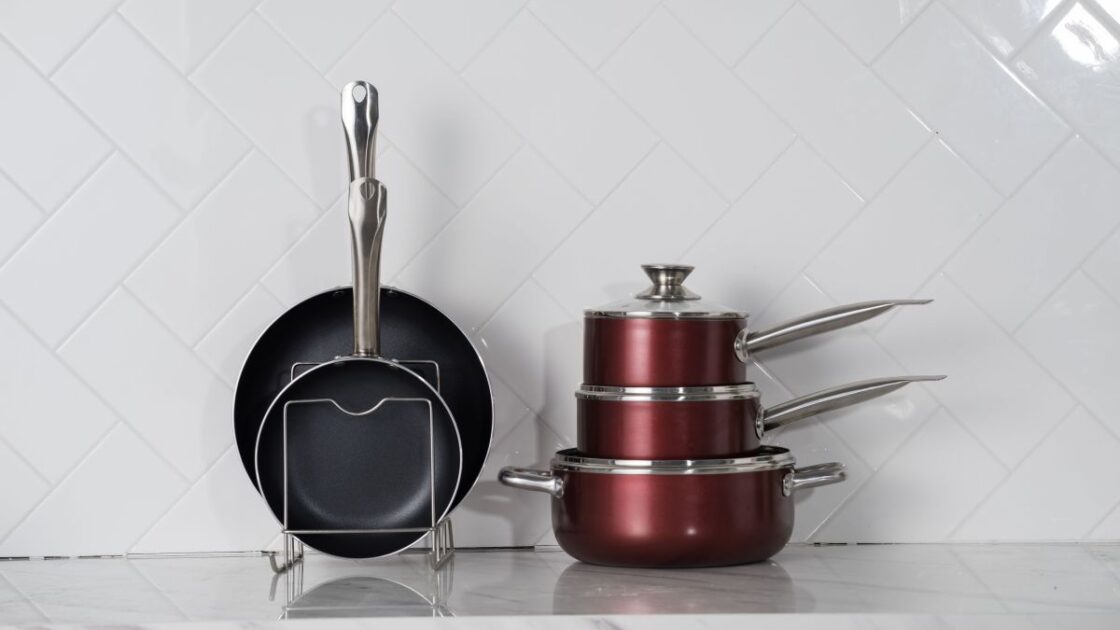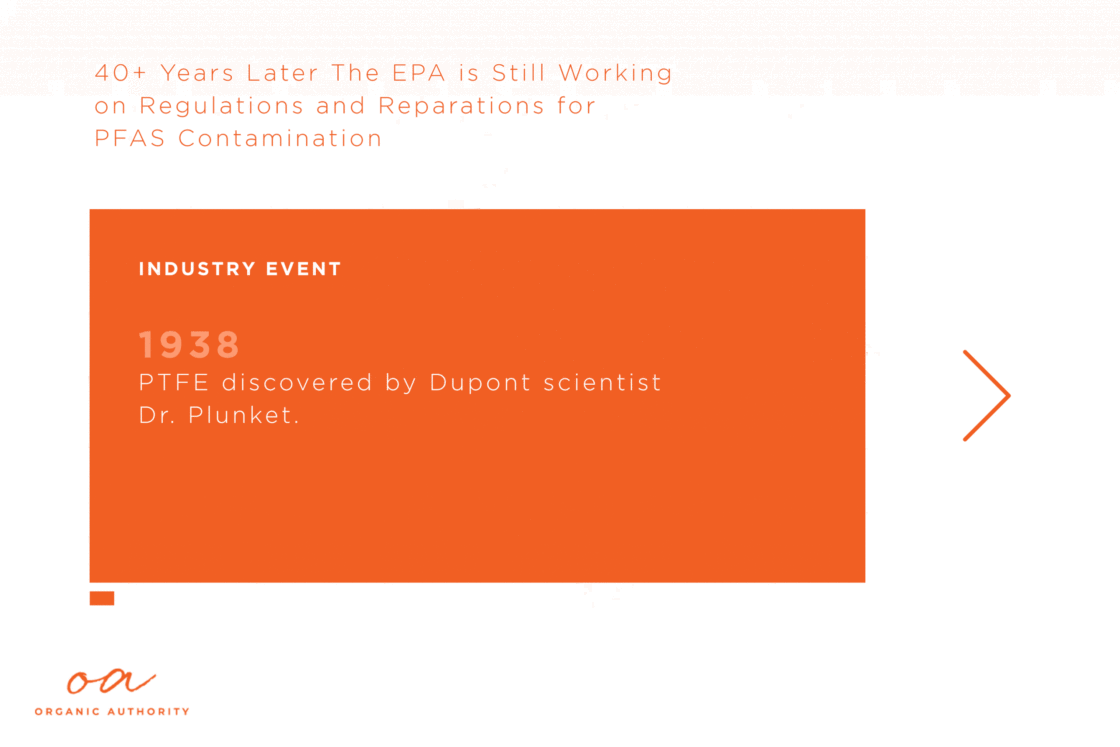The Reason PTFE Nonstick Pans Aren’t Safe: It Has Something to Do With Loose Regulations and Our Drinking Water
PTFE nonstick is still far from the safest option for your family. Let's dive deep into what all the acronyms mean and what they mean for your health. Oh, and we'll offer tons of safe alternatives.

You’re so careful with what food you buy, choosing organic (particularly when it comes to ingredients on EWG’s Dirty Dozen list) and doing your due diligence to seek out only the cleanest, most sustainable options for your family. But doing this work when it comes to cookware is just as important, if not more so, due to a hazy industry rife with misinformation.
To help you find the best nonstick cookware for you, we’ve rounded up our list of recommended, non-toxic, nonstick cookware brands, we share our top tested and reviewed ceramic cookware sets. And here we detail the differences between carbon steel, stainless steel, and cast iron to help you decide which is best for you. If you’re looking for non-toxic bakeware, see our guide to the best non-toxic bakeware materials and our top brand picks. To find out more about why this is so important, read on!
The world of nonstick cookware is more complicated than ever before. The point of contention has always been how PTFE nonstick coatings (AKA Teflon) have been produced: with toxic PFOAs. But while PFOAs have been phased out of nonstick cookware production under pressure from the EPA, did you know that the industry has simply swapped in another similar chemical called Gen X?
To hear the industry tell it, this Gen X is safer than PFOA. In reality, these claims remain unproven, and emerging evidence points to long-term health effects. Who wants to use their families as guinea pigs? Not us.
As consumers, our health and safety are casualties of secretive industries and a regulatory environment with a track record that is less than reassuring. We can either be victimized by the lack of transparency, or we can be informed and use our purchasing power to reward companies that create healthier and environmentally friendlier cookware.
How Chemicals Used in Producing PTFE Cookware Have Been Regulated

As the above timeline illustrates, regulation for the stuff that goes into making our cookware has a long, convoluted history.
From its inception in 1970, PFOA remained unregulated for 31 years – until the EPA pressured chemical companies to phase it out “voluntarily.”
And while the Toxic Substance Control Act was passed in 1976, 44 years later (and counting!), regulations and reparations for PFOA chemical contamination remain a work in progress. Not to mention that the parent class of chemicals (PFAS) to which PFOA belongs remains just as unregulated.
If you’re curious for a full picture of events, we’ve created a timeline here. But if you’re looking for the TL;DR… PFOA chemicals outlasted butterfly clips, Nokia phones, and boy bands, remaining in use during the production of our cookware and other PTFE products until 2015. These “forever chemicals” end up in our water supply and in our blood, posing multiple long term health effects.
At present, clean-up and reparations are still being worked out by the EPA.
Want more top picks? Sign up for the newsletter for more well-researched non-toxic living guidance / smart wellness advice.
The Dangers of PFAS Chemicals Today
PFOA is no laughing matter. While the end product, PTFE, certainly helps you fry eggs easily with next to no fat, PFOA has been linked to a number of health conditions including cancer, decreased vaccine response, elevated liver enzymes, pregnancy-induced hypertension, and preeclampsia. And according to human biomonitoring studies, it is now present in most people’s blood.
This is due not just to its long-time presence in cookware and other items, but also to unregulated dumping of these long-lasting chemicals into waterways over time. Researchers from the Environmental Working Group and Northeastern University found last year that at least 610 drinking water sources in 43 states were contaminated with potentially unsafe levels of PFAS, estimating that more than 19 million people may be exposed nationwide.
Gen X chemicals are the newest commonly-used ingredients used in nonstick coatings. A type of PFAS, these compounds are purportedly less toxic than PFOAs, but a lack of adequate testing leaves these claims far from airtight.
Due to slow-moving regulatory actions on the EPA’s part (see above timeline), concerns are rising that Gen X chemicals may also pose an environmental and public health risk.
Not only are the chemicals used to make PTFE nonstick cookware an environmental health hazard, but the coatings themselves have severe limitations. When heated over 500°F, PTFE-based coating fumes have also been shown to kill pets (especially birds) and may even cause “polymer fume fever” when inhaled.
And just because cookware is labeled “PFOA-Free” does not mean it was necessarily made without PFAS chemicals. If you can verify that the coating is PTFE-based, then it’s likely using Gen X during production. If the brand is not transparent about how it safely disposes of PFAS chemicals during production, pick instead one of the many safe, non-toxic, nonstick alternatives out there.
Quick Guide to Finding Clean, Healthy, Non-Toxic, Nonstick Cookware
Like you, we’ve been on the hunt for clean, non-toxic cookware for years. We’ve tried a lot of brands, and unfortunately, many pans fall short and fail to live up to their promises.
In our research, we’ve tried to seek out cookware with safe and seasonable cooking surfaces that exhibit nonstick properties.
When Shopping for Nonstick, Nontoxic Cookware, Keep These Tips in Mind:
1. Be wary of too-cheap cookware.
If the price seems too good to be true, it probably is! Cheap nonstick cookware can flake off more quickly, crumbling into your food (and leeching the aluminum core beneath the coating itself into whatever you’re cooking). Look for cookware brands that have made commitments to protecting the environment and whose artisan craftsmanship will give the cookware longevity, making it a worthwhile investment.
2. Choose the right materials.
When opting to avoid PFOAs entirely, carbon steel, cast iron, and ceramic coated pans are often good choices. But even these surfaces have their limitations, and it’s important to understand the properties of the cooking materials you choose.
Stainless steel and cast iron, for example, have been shown to leech heavy metals like nickel and iron when in contact with acidic foods. While trace amounts are safe for most people, nickel may cause allergic contact dermatitis, according to the Agency for Toxic Substances & Disease Registry.
Cast iron specifically can also leech a sizable amount of iron into food. Of all of the micronutrients, iron is one of the riskiest to overload on. While this is less of a worry for some groups than others (vegetarians, menstruating women, and people prone to anemia) for others, especially those who eat a lot of red meat, this could be an issue. If you suspect your iron is either low or high, ask your doctor and get your iron levels tested. Another tip: look for enamel-coated cast iron cookware.
Cheaply-sourced aluminum is another potentially problematic material that can result in lead contamination if the pan is not anodized or coated with a nonstick coating, according to one study published in 2017. To avoid this problem, buy from brands that produce in regions with heavy regulatory oversight, like the U.S. or European Union.
3. Give it a test drive.
If you’re not sure which brand, or cookware type, is right for you, consider buying just one pan from each line and trying it out at home! Once you’ve found the cookware you like, you can buy up the rest of the line (or mix and match to build an eclectic and versatile personal collection of pans that do what they do best: nonstick ceramic for low- and medium-heat cooking, for example, and carbon steel, stainless steel or cast iron for searing). If there’s a pan you don’t fall in love with on your search, consider giving it away to a friend or donating to a charity like Big Brothers Big Sisters or Goodwill, to make sure that it has a long and fruitful life.
Now that you know, you can make good decisions for your home, health, and planet. And if you need some guidance, take our home chef quiz, and we’ll provide you with more specific recommendations.
If you want to learn more about safe cookware and how it’s made, read our deep dive interviews with Made In cookware, GreenPan, Caraway, Xtrema and Staub. Each cookware brand has their own unique style of cookware.
P.S. Did you know? Organic Authority has its own nutrition and wellness shop to meet your needs and help you take control of your health. Shop clean supplements for energy, sleep, inner beauty for skin support, protein, workouts, pantry items and more. Shop The Organic Authority Shop now.
Related on Organic Authority:

‘Forever Chemicals’ In Your Sparkling Water: Is It Safe to Drink?
Xtrema Cookware Reviewed & Tested: Ceramic Cookware at It’s Best
For Non-Toxic Nonstick Cookware, These 5 Sets from GreenPan Are No-Brainers
*Affiliate disclosure: Our team researched far and wide to find safe and clean bakeware options you’ll love using for all kinds of sweets and treats. If you make a purchase after clicking our links, Organic Authority may earn a commission, which goes a long way to support the good work our team does and reduces the number of ads we serve (as well as our Valrhona Chocolate habit.) Learn more.

